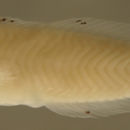en
names in breadcrumbs


Description: Body relatively thin, narrow and long with a large eye and a terminal, small mouth. Pectoral fins medium, reach to vent. Pelvic fins very short. Dorsal and anal-fin bases long, caudal peduncle short and relatively wide. Melanophores limited to the fin-ray membranes, typically occurring in five groups: at the front, mid, and rear dorsal fin and the front and rear anal fin. Each melanophore group covers from one to five fin spines or rays. Series of transitional larvae show development of the eye from vertically oval (and tilted backward) to round (round in many larvae captured over the reef). Transitional recruits of H. bivittatus have a mid-dorsal fin ocellus and a mid-lateral body stripe extending directly rearward from the eye, present even in the earliest transitional stages. Transitional recruits on the reef commonly show remnants of the larval melanophores on the fin membranes.
Halichoeres bivittatus larva
Halichoeres bivittatus larva
Diagnosis: The fin-ray count of D-IX,11 A-III,12 and Pect-13 indicates Halichoeres and is shared by most of the Caribbean species. Larval H. bivittatus are identical to most other larval Halichoeres with five patches of median-fin melanophores and can only be identified by DNA sequencing.
The slippery dick (Halichoeres bivittatus) is a species of wrasse native to shallow, tropical waters of the western Atlantic Ocean.
The slippery dick wrasse is a small fish that can reach a maximum length of 35 cm.[2] It has a thin, elongate body with a terminal mouth, and its body coloration has three phases during its life:
The slippery dick wrasse is widespread throughout the tropical and subtropical waters of the western Atlantic Ocean. It can be found from North Carolina and Bermuda to Brazil,[2] including the Gulf of Mexico and the Caribbean Sea area.
The slippery dick wrasse is generally reef-associated at depths from 1 to 15 m (3.3 to 49.2 ft), but it's not very common in seagrass.[6][7]
This species feeds on benthic invertebrates, including crabs, small fishes, sea urchins and ophiuroids, polychaetes, and gastropods.[7][8]
It is a protogynous hermaphrodite.[2] These fish form leks while breeding.[2] In North Carolina, males defend temporary territories with peak spawning in May and June. Pair spawning typically occurs between females and terminal phase males; initial phase males occasionally try to insert themselves into the spawning event.
This species is widespread and very common throughout much of its range in the Caribbean and Florida, although it is uncommon in northeastern Brazil. There are no major threats known to this species, and population trends are unknown. It is listed as Least Concern (LC) by the IUCN.[1]
The slippery dick (Halichoeres bivittatus) is a species of wrasse native to shallow, tropical waters of the western Atlantic Ocean.